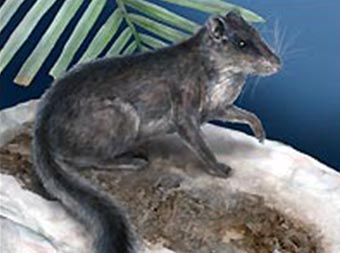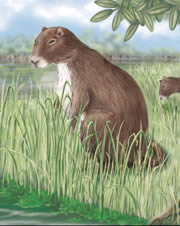

BBC - March 9, 2006
A squirrel-like rodent discovered in Laos is the sole survivor of a group that otherwise died out 11 million years ago, according to fossil data.
The animal made headlines in 2005 when it was hailed as the only new family of living mammals to be found in 30 years.
But scientists now believe it is a "living fossil", the relic of a group of prehistoric rodents once widespread in South East Asia and Japan.
Writing in Science magazine, they say efforts must be made to conserve it.
The rodent, Laonastes aenigmamus, was found by scientists at a hunter's market in Laos in early 2005.
Robert Timmins, from the Wildlife Conservation Society, saw it on sale next to some vegetables.
"I knew immediately it was something I had never seen before," he said at the time.
While previously unknown to the worldwide scientific community, it is familiar enough to local people to have a name, the kha-nyou.
The creature has dark-grey fur and is about the size of a red squirrel. It has short legs, a hairy tail and a long snout.
Fossil puzzle
After the kha-nyou was discovered, specimens were sent to London's Natural History Museum, to compare with material in its vast research collections.
Based on differences in the skull, teeth, bones and other body features together with DNA analysis, scientists said it was an entirely new rodent family more closely related to rodents in Africa and South America than in Asia.
But when a particularly impressive fossil of a long-extinct rodent was unearthed in China last summer, a US-led team wondered whether the kha-nyou might be a living member of the long-gone family.
They went back through the fossil evidence and found that the kha-nyou's skull, teeth, lower jaw-bone and other skeletal characteristics were a striking match to the fossil.
They believe it belongs in the same group - the otherwise extinct rodent family Diatomyidae.
Chief author Mary Dawson, of the Carnegie Museum of Natural History in Pittsburgh, said it was extremely rare for a mammal to reappear after such a long gap in the fossil record.
"A new family of living mammals does not crop up every day," she told the BBC News website.
"When we have a living fossil it opens up a way of looking at past biodiversity on the molecular level that we don't ordinarily have."
Nocturnal recluse
Laonastes lives in a rocky limestone area dotted by small patches of forest.
It is thought to be nocturnal but has yet to be observed by biologists in the wild.
Dr Dawson said efforts to conserve Laonastes should be given the highest priority.
"We don't know what its status is - whether there are a lot of them around or just a few," she said.
"This animal better be protected while it is (still) around."
Exciting finds
The area of South East Asia where the rodent was found is regarded as one of the richest "hotspots" of biological diversity in the world.
Several other new mammals have been found there in recent years, including a new species of bat, a mouse-like rodent and a hedgehog-like mammal.
"It is highly likely that there are more exciting and unusual animals to be found in South East Asia," said Paula Jenkins, of London's Natural History Museum, who carried out the original analysis of Laonastes.
The latest evidence is described in the current issue of the journal Science, by authors from the Carnegie Museum of Natural History in Pittsburgh, US; Montpellier University, France; and the Institute of Vertebrate Palaeontology and Palaeoanthroplogy in Beijing, China.

Nature - September 2003
Cow-sized guinea pigs grazed the riverbanks of South America about five million years ago, confirms a newly found skeleton.
This biggest-ever rodent, Phoberomys patersoni, shared its home with two-metre turtles, ten-metre crocodiles and three-metre carnivorous birds. "It was a land of giants," says co-discoverer Marcelo Sánchez-Villagra of the University of Tübingen, Germany.
Named Goya, after the Venezuelan site where its bones were found, the buck-toothed behemoth probably weighed in at 700 kilograms and sported a tail. Phoberomys' closest living relative is probably another hefty guinea-pig lookalike, the forest-dwelling pacarana, which weighs 15 kilograms. Today's largest rodent is the sheep-sized capybara, also South American. The continent was once home to several more extinct rodents that weighed more than 100 kg.
Rodents of unusual size
Guinea pigs' ancestors probably arrived in South America from Africa about 40 million years ago. They found a continent with few large herbivores, and evolved to fill the niche - Goya's teeth show that he or she ate grass. Big animals have slower metabolisms, so they need proportionately less food, and their large guts are good for digesting tough plants. But they may have died out due to their sluggish movement. Most successful modern large herbivores, such as antelopes, are long-legged and fleet-footed. Rodents have short legs and big paws, which are good for digging burrows. "Being a really big rodent, you're slower than the competition," says evolutionary biologist Robert McNeill Alexander of the University of Leeds, UK.
The crocodiles, birds and cat-like marsupials that might have eaten Phoberomys were probably not speedy. But the influx of competitors and predators from North America when the two continents joined three million years ago would have been bad news. This and climate change probably finished off the hapless rodent.
Phoberomys was previously known from fossil teeth and a few fragments of bone. Sánchez-Villagra and his colleagues found Goya's skeleton in the desert region of Urumaco. When Phoberomys lived there, it was swamp.
Few fossils have been found in northern South America, as most of the land is covered in forest. The skeleton will go on display in the Natural History Museum in Caracas. Meanwhile, the world record for the largest-ever marsupial has just doubled.
Diprotodon optatum, a sort of immense wombat, weighed in at about 2,800 kg - not the 1,175 kg previously suggested - calculate Stephen Wroe and his colleagues at the University of Sydney. They base their new estimate on measurements of bones and on comparisons with other animals. Previous figures were "educated guesswork", says Wroe. Some researchers had thought Australia's poor soil could not support enough plants to feed large herbivores. But the animal's sudden weight gain takes it beyond any living land animal apart from elephants.